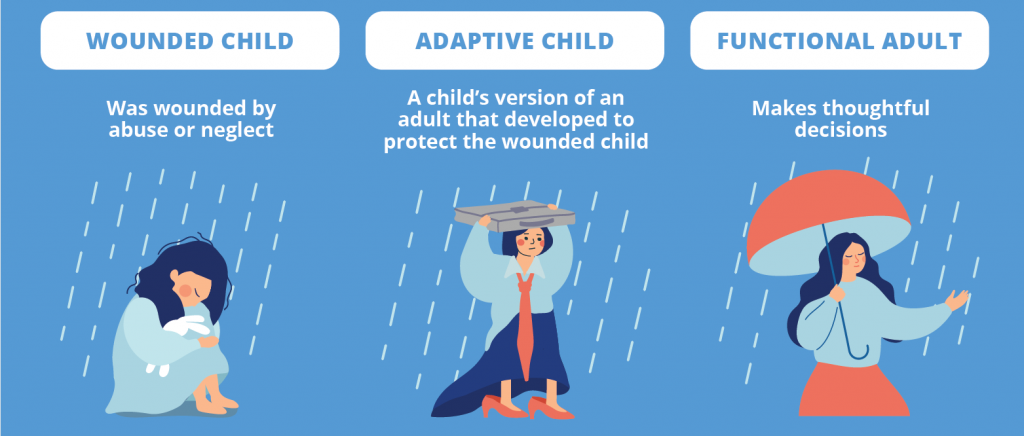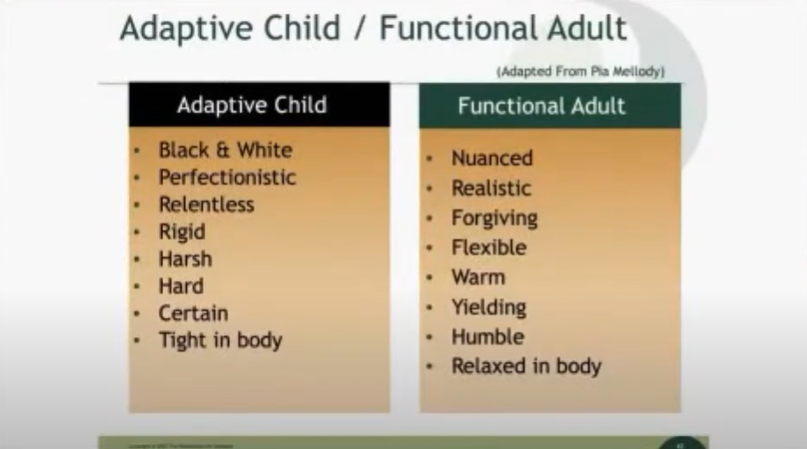Estimated reading time: 9 minutes

We all have relational wounds which result in us developing an Adaptive Child part to cope with these wounds. None of us escapes without being disappointed, hurt, overwhelmed or left alone sometime in childhood. These relational traumas can happen in small or big ways and may have occurred once, sometimes or often. As trauma expert Peter Levine says, trauma will visit each of us at some stage of life. Yet he also offers this reassurance: “Trauma is a fact of life. But it doesn’t have to be a life sentence.”
Our minds and bodies hold traces of most events from our past. They do this because evolution wired us to prioritise survival and to learn from experience, particularly negative experience. In fact, our neurobiological reactions to triggers are inbuilt survival mechanisms to keep us safe and protected. In spite of that, if our reactions are too frequent or extreme, as may happen after trauma, they interfere with our ability to engage in healthy adult relationships. Learning how to manage our nervous system’s reactivity is the key to our individual and relational healing.
Mind and body are one
Because our mind (psyche) and body (soma) are intricately interconnected, a quick way to calm down and feel safe is to focus on our body, our breath or any one of our five senses. These are the self-soothing techniques we need to practice by feeling into, listening to, moving with and responding to our body. Our body can help us to quickly reconnect to present-time.
We must remember that when we’re triggered it’s not only a psychological reaction, but also a physiological one. These reactions are hard-wired into our nervous system, especially the autonomic (automatic) nervous system. We can’t stop being triggered, but we can learn to manage ourselves when we are, by using self-soothing techniques as soon as we’re triggered.
Three parts of our psyche
One useful model to understand our mind/body reactions is to think of them as coming from three parts of our psyche; the Wounded child, the Adaptive Child and the Functional Adult. The summary below from the NICABM infographic is based on Terry Real’s work on How Trauma Can Affect Adult Relationships.
- The Wounded Child was hurt by abuse or neglect. It’s a very young, vulnerable, often pre-verbal part of our psyche that lives in past-time. It’s often overwhelmed and longs for connection. Much trauma work focuses on the wounded child. But it’s not usually the wounded child that brings dysfunction to adult relationships.
- The Adaptive Child developed to protect the Wounded Child. It is a later developing child part that also lives in past-time and cares only about self-protection. It’s unwilling and/or unable to learn new skills. It is a child’s version of an adult which developed in reaction to and resistance against its wounds. It also learnt to model or imitate the dysfunctional behaviour of the parent they were resisting or reacting against. It is often perfectionistic, unforgiving and harsh because it sees the world as black and white. It views intimacy and closeness as a threat, so it’s often reactive in relationships if it doesn’t get its own way.
- The Functional Adult makes thoughtful decisions. It is adult, mature, nuanced and willing to overlook mistakes. It is based in present-time and understands imperfection and ambiguity. It makes sense of past wounds and trauma and their impact on relationships. It is flexible and can learn new skills.
How to engage the Functional Adult
To engage the Functional Adult, we need to focus on working with the Adaptive Child, not the Wounded Child. The above model helps us understand the consequences of our relational wounds/trauma. By engaging with our bodies (soma) and minds (psyche) using evidence-based trauma treatments, we can learn to relate to others from our most thoughtful, mature self. This is the power behind psychosomatic treatments.
We must learn to self-soothe the hijacked parts of our brain and autonomic nervous system until we feel calm, collected and connected. According to Terry Real, the goal in relationship is to be connected and protected. Only then can we respond and interact moderately and respectfully from our Functional Adult part. Without the presence of both connection and protection, we will struggle with self-esteem and boundary issues. Try this self assessment to see where you may be getting stuck.
We cannot use communication and conflict management skills adequately while our body is triggered and reactive because our thinking brain is hijacked. These result in reactions from our Adaptive Child parts whose sole motto is “It’s you against me and me against you”. When we’re triggered our Adaptive Child parts literally feel and behave as if they’re in a fight for survival. And they fight like immature kids.
Below is my adaptation of Crystal Arber’s depiction of the Adaptive Child and Functional Adult. She was also inspired by Terry Real.
Snapshot of the Adaptive Child
I am the child that had to adapt to the family and circumstances I grew up in. I did a great job of adjusting to my environment. I made sure my parents, siblings, pets & duties came before me. This seemed to calm my angry parent’s moods, which happened especially if alcohol or other substances were involved. I had to figure out when my authoritarian parent was about to rage on me, attack me or bully me. I was mostly pretty good at figuring out what this angry parent needed, and I was fairly good at either staying away or being one step ahead of the next attack. Sometimes I couldn’t figure it out and I paid a price. This taught me I had to get better at reading other people. So now I am hypervigilant against any possible attack and sometimes I behave exactly like my angry parent when I don’t get my way. My other parent was absent and neglected me. They didn’t know how to take care of me. This absent parent was too absorbed with themselves or their own pain about my authoritarian parent to protect me or be there for me.
Today I struggle as an adult. I would like to be a Functional Adult, but often my Adaptive Child part runs my day. This usually doesn’t work out very well because my Adaptive Child is young and immature so doesn’t understand how to live in the adult world. I get accused of over-reacting or shutting down. I have difficulty in my adult relationships because I’m still stuck in past-time reacting to my dysfunctional family. I relate to my partner and friends as if they are the family I grew up with when I was young.
Nature and Nurture
We are all products of the interaction between nature and nurture. When our Adaptive Child parts don’t feel safe, as happened in our past environment (nurture), they react/resist in very predictable ways which are based on our unique neurobiology (nature). These predictable reactions are hard-wired by evolution and result in fight, flight, freeze, submit & cling survival behaviours.
These five survival behaviours make up the triggered “stance” of the Adaptive Child in reaction to our partner. It contributes immensely to the dysfunctional “dance” we do together. Our job is to understand that we all have triggers, not only us but also our partners. Our partners are struggling with their reactions too! We can’t change our partner (which our Adaptive Child often tries to do), but we can influence our partner by changing ourselves to become more grounded in our Functional Adult. That’s how we have mature and functional adult relationships.
Snapshot of the Functional Adult
I am a Functional Adult who operates from a mature and moderate state of being. I know how to take care of myself, even if I don’t feel like it. I can distinguish my needs from my wants. I understand that I alone am responsible for meeting my basic needs: sleep, healthy eating, connecting with others and self-care. I can set proper internal and external boundaries. But I haven’t forgotten that my Adaptive Child is still with me – trapped in past-time. Even when my Adaptive Child is triggered and wants to rage against the world or hide to escape from it, I have the skills to stay in present-time and make rational instead of reactive choices. As a Functional Adult I can maintain and regain control of myself in present-time, even though my Adaptive Child is triggered in past-time.

We all have different triggers
We and our partner have different triggers and initial, reactive “stances”. To thrive in relationship, we all must learn about and practice moderating this reactive stance via self-soothing. It’s an inside job that only we can do. This is part of the process of developing differentiation between ourselves and our partner. Only then can we to turn towards our partner to practice a new relational “dance” together. This is the process of creating and earning secure attachment. Self-soothing is the first step in differentiation, the development of which allows us to create a satisfying, secure and sexual adult relationship.
Terry Real, sums up the process of improving our relationship as having three main steps:
- First, we have to confront our own trauma triggers and the life experiences that shaped them
- Second, we have to do some trauma work in order to unpack these triggers and move past them by using self-soothing techniques whenever they arise, which is often many times every day.
- Third, we will need to learn and practice effective relational strategies when these triggers arise.
For help in learning to manage your Adaptive Child by parenting it from the inside with your Functional Adult, Call 0421 961 687 or email us to schedule an appointment. International callers should call +61 421 961 687.
You deserve the best trained relationship coaches if you’re planning to invest time and money in your relationship. If you’re not ready to book an appointment, call us on 0421 961 687 to book a FREE 15 minute phone consultation to discuss how we may be able to assist you.
Further Resources
- Types of Parenting Styles – Available at https://www.parentingforbrain.com/wp-content/uploads/Types-Of-Parenting-Styles.pdf
- Nature’s Lessons in Healing Trauma: An Introduction to Somatic Experiencing® (SETM). (2014). YouTube. Available at: https://www.youtube.com/watch?v=nmJDkzDMllc.
- Levine, P.A. (2012). In an Unspoken Voice: How the Body Releases Trauma and Restores Goodness. 1st edition ed. [online] Amazon. North Atlantic Books. Available at: https://www.amazon.com/Unspoken-Voice-Releases-Restores-Goodness-ebook/dp/B009BVWRLO/ref=tmm_kin_swatch_0?_encoding=UTF8&qid=&sr=.
- Real, T. (2022). Ellyn Bader, How Trauma Shows Up in Couples. mp4. [online] Vimeo. Available at: https://vimeo.com/705466777
- Big Think (2021). What is trauma? Bessel van der Kolk, author of ‘The Body Keeps the Score’ explains. YouTube. Available at: https://www.youtube.com/watch?v=BJfmfkDQb14

Hi, This resonated greatly with the dynamic of what I am in, in a relationship right now. Would like to learn more
Hi Joe, if you’d like to learn more, I recommend you look at Terry Real’s work such as Learning to Live a Non-Violent Life.